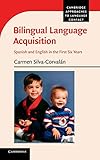Bilingual language acquisition : Spanish and English in the first six years / Carmen Silva-Corvalán, University of Southern California.
Material type: TextSeries: Cambridge approaches to language contactPublication details: New York : Cambridge University Press, 2014Edition: 1st edDescription: xxv, 408 pages : illustrations ; 24 cmContent type:
TextSeries: Cambridge approaches to language contactPublication details: New York : Cambridge University Press, 2014Edition: 1st edDescription: xxv, 408 pages : illustrations ; 24 cmContent type: - text
- unmediated
- volume
- 9781107024267 (hardback)
- 9781107673151 (paperback)
- 460.4221 23
- P118 .S4576 2014
- LAN009000
| Item type | Current library | Call number | Status | Date due | Barcode | |
|---|---|---|---|---|---|---|
 Books
Books
|
Centeral Library First floor - Languages | 460.4221 S.C.B 2014 (Browse shelf(Opens below)) | Available | 23802 |
Browsing Centeral Library shelves, Shelving location: First floor - Languages Close shelf browser (Hides shelf browser)

|

|

|

|

|
No cover image available | No cover image available | ||
| 458.2421 O.A.I 2002 In viaggio : | 458.2421 O.A.I 2002 In viaggio : | 458.2421 O.A.I 2002 In viaggio : | 460.4221 S.C.B 2014 Bilingual language acquisition : | 468 A.E.M 2007 Metodo de Espanol para extranjeros, prisma de ejercicios/ Method for Spanish Foreign, Prism of Exercises: Nivel Inicial A1 + A2 Fusion / Inicial Level / | 468 A.E.M 2009 Metodo de Espanol para extranjeros, prisma Nivel Inicial/ Prism of Exercises: Nivel Inicial A1 + A2 Fusion / Inicial Level / | 468.2 H.S.L 1995 Learn to speak Spanish |
Includes bibliographical references (pages 380-398) and indexes.
Machine generated contents note: 1. Introduction; 2. Methodology; 3. Bilingual development: a linguistic profile of the first six years; 4. Subjects in English and Spanish; 5. The order of constituents: subject position in Spanish and English; 6. The acquisition of ser, estar, and be; 7. The development of verb morphology: learning how to mark tense, aspect and mood; 8. Discussion and conclusions; Appendices: 1. Transcription instructions; 2. Calculation of MLUw; 3. Spanish adjectives used with copulas up to age 6; 4. The siblings' early verb lexicon in English and Spanish; 5. Excerpt of adapted Goldilocks story.
"How do children develop bilingual competence? Do bilingual children develop language in the same way as monolinguals? Set in the context of findings on language development, this book examines the acquisition of English and Spanish by two brothers in the first six years of their lives. Based on in-depth and meticulous analyses of naturalistic data, it explores how the systems of both languages affect each other as the children develop, and how different levels of exposure to each language influence the nature of acquisition. The author demonstrates that the children's grammars and lexicons follow a developmental path similar to that of monolinguals, but that cross-linguistic interactions affecting lexical, semantic and discourse-pragmatic aspects arise in Spanish when exposure to it diminishes around the age of four. The first of its kind, this original study is a must-read for students and researchers in bilingualism, child development, language acquisition and language contact"--
There are no comments on this title.

